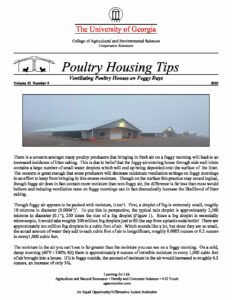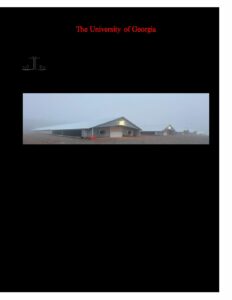There is a concern amongst many poultry producers that bringing in fresh air on a foggy morning will lead to an increased incidence of litter caking. This is due to belief that the foggy air entering house through side wall inlets contains a large number of small water droplets which will end up being deposited onto the surface of the litter. The concern is great enough that some producers will decrease minimum ventilation settings on foggy mornings in an effort to keep from bringing in this exc...ess moisture. Though on the surface this practice may sound logical, though foggy air does in fact contain more moisture than non-foggy air, the difference is far less than most would believe and reducing ventilation rates on foggy mornings can in fact dramatically increase the likelihood of litter caking.
Though foggy air appears to be packed with moisture, it isn’t. First, a droplet of fog is extremely small, roughly 10 microns in diameter (0.0004")1. To put this in perspective, the typical rain droplet is approximately 2,500 microns in diameter (0.1"), 250 times the size of a fog droplet (Figure 1). Since a fog droplet is essentially microscopic, it would take roughly 200 million fog droplets just to fill the cap from a plastic soda bottle! There are approximately ten million fog droplets in a cubic foot of air. Which sounds like a lot, but since they are so small, the actual amount of water they add to each cubic foot of air is insignificant, roughly 0.0002 ounces or 0.2 ounces in every1,000 cubic feet.
The moisture in the air you can’t see is far greater than the moisture you can see on a foggy morning. On a cold, damp morning (40oF / 100% Rh) there is approximately 6 ounces of invisible moisture in every 1,000 cubic feet of air brought into a house. If it is foggy outside, the amount of moisture in the air would increased to roughly 6.2 ounces, an increase of only 3%.
The amount of moisture in foggy air appears greater than it actually is because we are unable to see through an individual droplet of fog due to light refraction. Up close, even though there may millions of droplets within a foot or two of your nose, they are so small that your sight will not be obstructed. But the farther away you look, the greater the number of droplets you are looking through, each of which is obstructing a very small portion of your view. Millions of small white dots turn into billions, trillions, quadrillions, quintillions, etc. as you look further and further away. Eventually, the additive effect of all the droplets will totally obstruct a person’s view. The denser the fog, the quicker a person’s view is obstructed. But it is important to keep in mind that even in a very dense fog there is still relatively very little additional moisture in the air.
In many ways, whether litter moisture increases on a cool, damp morning has more to with where incoming air goes once it enters a house than the moisture content of the air. If the incoming air quickly falls to the floor upon entering a house, it will chill the birds and remove little moisture from the litter, leading over time to caked litter...after all, it is difficult dry anything with cool, damp air. But, if the same air moves along the ceiling until it just makes it to the center of the house, then gently moves down toward the floor, the story is very different.
We want to maximize the distance the incoming air travels before moving down to floor level so it can be throughly heated by the warm air collecting at the ceiling that has been put off by the heating system as well as the birds (Figure 2). During the time the air spends near the ceiling, the temperature of the air increases and the relative humidity of the air decreases, making it easier to remove moisture from the litter without chilling the birds. In fact, for every 20oF the temperature of the incoming air increases, the relative humidity is in cut in half due to the increased moisture-holding capacity of warm air and as a result, the ability of the air to remove moisture from the litter is dramatically increased. The more the air can be warmed before moving down to floor level, the more moisture each cubic feet of air can hold, the fewer cubic feet that needs to be brought in to a house to remove the moisture the birds are continuously adding to the litter. When it comes to litter moisture removal, the “quality” of the air moving over the litter is just as, if not more important than, the volume of the air brought into a house.
Yes, when it is cold and damp outside exhaust fans are bringing moisture into a house. And yes, it is more difficult to remove moisture from a house on a cold, humid day than on a cold, dry day. But, reducing ventilation rates will not result in drier litter. For instance, if in a 40' x 500' house the air temperature is 80oF and the relative humidity is 50%, there will be roughly 15 ounces of water in every 1,000 cubic feet of air in the house (obtained using the Poultry411 app). Assuming a house volume of 180,000 cubic feet (9' average ceiling height), there would be 2,700 oz (21 gallons) of invisible moisture in the air. If there were 20,000 two-week-old birds in the house, they would add this same amount of moisture, 21 gallons, to the house every 45 minutes. If ventilation rates were to be decreased on a cold, foggy morning, though less “outside moisture” would be brought in, it wouldn’t take long for the “inside moisture” being added by the birds to build-up, resulting in caked litter.
It may be best to think of ventilating on a foggy day in this manner. Your sink is leaking water onto the floor. Someone is handing you dry towels to soak up the water off the floor. A towel gets wet, you get rid of it, and another dry towel is handed you. It gets wet, they hand you another. You are keeping up with the flow of water from the leaking sink. You run out of dry towels and you are handed a a partially dried towel. Do you tell them that you don’t want the towel because it is not perfectly dry? Of course not. It will obviously take more towels to keep the leak from spreading across the floor, but in the end a partially dried towel is better than no towel at all. When it is cold and damp outside, with or without fog, to keep the litter dry we need to make sure the incoming air is partially dried before it moves down to floor level. Yes, it will not be as dry as it would be on a cold, dry morning but every minute the birds are adding moisture to the litter and conditions can quickly made worse if less fresh air is brought into the house. The fact is, on cold, damp mornings (with or without fog) ventilation rates may need to be increased 10 to 20% to take into account the incoming air contains a little more moisture. But keep in mind the better job you do of warming the incoming air, the better job you will do of drying your “towels,” the fewer of them you will need, and the better chance you will have keeping your litter dry.
ATTACHMENTS
Details
| Year | Volume | Number | Categories |
|---|---|---|---|
| 2020 | 32 | 9 |


